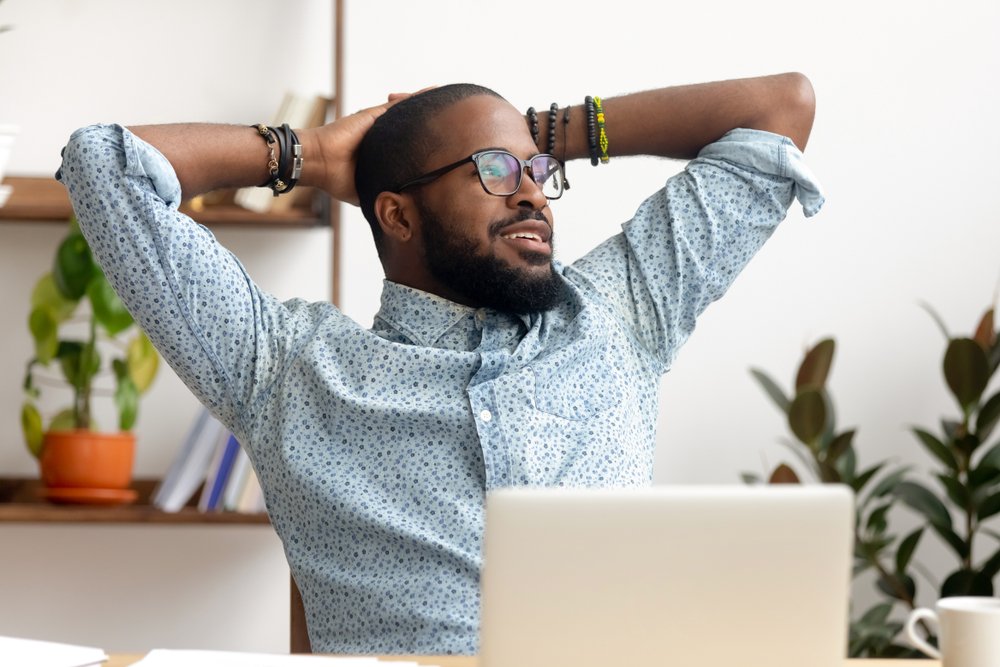What exactly is Niksen, the Danish art of doing nothing? Dee Marques takes up the arduous challenge of, well, sitting and doing very little at all, in order to discover the benefits it can bring to the mind and body.
Have you ever needed a break urgently, but then felt bad about taking it? Unfortunately, many of us feel guilty about doing nothing due to the belief that we must constantly be achieving or producing something, otherwise we’ll be branded as lazy. So when we hear about trends that embrace “the art of doing nothing”, we might equate them with a character flaw or roll our eyes incredulously.
I’ll admit that I’m guilty of this, so before writing this article I did several 10-minute sessions trying to experience what the art of doing nothing felt like. And, initially, I will admit that it felt stressful. The first time I sat in my crafts room and my eyes instantly wandered to my book shelf, so I started to think about all the books I hadn’t managed to read yet.
Then I saw my box of sewing UFOs (unfinished objects) and felt the pressure to get on with them. The art of doing nothing at all is such an alien concept that my husband even walked in while I was staring out of the window and asked me “are you OK?”, which shows that we’ve come to see idleness as a sign that something must be wrong.
Indulge in the art of doing nothing shutterstock/stockfour
The problem is that being constantly on the go can raise stress levels, cause anxiety, and interfere with getting better sleep. This can get us into a catch-22 situation: being tired and stressed can lower productivity, and the fewer things we get done, the more stressed we become and the more we push ourselves, which is the perfect recipe for burnout.
Moreover, the COVID pandemic has changed many things. Whereas before staying in was a way to relax and de-stress, that’s no longer the case for many people who feel antsy having their busy schedule disrupted. But at the same time, lockdowns have created an opportunity to explore our habits and whether we use time in the best possible way. So, there's never been a more appropriate time to ask why we should incorporate the art of doing nothing into our daily routine.
What is Niksen, the art of doing nothing?
Niksen is a Dutch word that’s hard to translate into English, although that doesn’t mean that the art of doing nothing can’t be learned! Olga Mecking, author of a book on how to embrace the art of doing nothing, defines Niksen as doing something without a purpose. Indeed, the only purpose of Niksen is to enjoy the feeling of doing nothing. It’s similar to the Italian expression dolce far niente, the sweetness of doing nothing.
“Mastering Niksen – the art of doing nothing – can counter the constant bombardment of information we’re exposed to in everyday life.”
Before moving on, we should clarify what Niksen is not. It’s not mindfulness, where we are trying to pay attention to our immediate thoughts and surroundings. During Niksen, the mind roams free. And it’s not laying on the sofa looking at our social media feed, because when we do this the wheels are still spinning. There’s a difference between laying on the couch while scrolling through your phone and simply laying on the couch, just because.
The art of doing nothing is about being idle. It could be something like simply sitting in a chair or looking out the window, which is still an action but doesn’t have an ultimate purpose or intention.
What are the benefits of practising Niksen?
The Netherlands is often ranked among the world’s happiest countries and in 2021 it made it to the top five. Could one of the reasons why this nation is so joyous be due to the fact that the Dutch embrace the art of doing nothing?
Happiness requires good mental and physical health. Practising Niksen gives the mind and body a break, and as research has proven, slowing down can lower stress and strengthen the immune system. Carolien Hamming, one of the experts on Niksen, says that we need to be recharged, just like we recharge our mobile phones when they run out of battery. Doing so will make us less vulnerable to physical and mental burnout.
MORE LIKE THIS:
- Feel Stress-Free Fast – 11 Science-Backed Techniques
- The Power of Pottering Around
- How to Protect Your Energy: 7 Science Backed Techniques
Mastering the art of doing nothing can counter the constant bombardment of information we’re exposed to in everyday life. Studies show that our brain has to process approximately 74GB of information every day, which is equivalent to 16 movies. This can easily cause feelings of exhaustion and some researchers suggest it can interfere with decision making, unless we start to fully embrace the art of doing nothing.
Niksen lets your mind take a break shutterstock/fizkes
Japanese doctor Naoko Yamamoto – who has lived in the Netherlands for years – knows what benefits the art of doing nothing can bring. According to her, Niksen is more than a way to manage stress: those peaceful, reflective moments can become sources of inspiration. Studies confirm that a wandering mind isn’t necessarily a bad thing, and there’s a whole book written on the impact of mind idleness on creativity and problem solving.
So, how do you practise Niksen?
After reading more about Niksen, I tried some more do-nothing sessions and noticed that the experience stopped being so stressful. Granted, doing nothing isn’t easy in societies where a fast-paced lifestyle is the norm, and letting the mind wander is easier said than done, but it is possible. Here are few guidelines to help you start practising the art of doing nothing:
-
Start small and aim for a few minutes at the time. This site can be useful.
-
Schedule Niksen time several times a day. Personally, I've found it helpful to practise it in between tasks when working from home, as it gives me a clean break.
-
Expect to feel guilty or weird at first, and stop if you notice negative thoughts or you start worrying or ruminating.
-
Make it a device-free space.
-
Choose something that doesn’t require thinking.
-
Back at school, you were probably told to focus and stop daydreaming! But daydreaming can be Niksen, as it doesn’t achieve anything and serves no particular purpose; it’s just letting the mind go where it wants to go.
-
Go for a walk without planning the route in advance; just go where your feet take you.
-
Remember the story about Isaac Newton and the apple falling from a tree? What was he doing under a tree anyway? Probably indulging in the art of doing nothing. So why not “just” sit under a tree?
-
You can be doing something physically and at the same time keep your mind in Niksen mode. For example, birdwatching or knitting repetitive stitches.
-
Make the most of the wet spring weather and just sit by a window watching the rain fall.
-
Have a pet? Watch them for a while. They’ll probably be doing Niksen too!
-
As suggested in this first-person account, Niksen can even be something seemingly boring and irrelevant, like just watching coffee brew.
- Whatever you do, don’t multitask during Niksen time.
Conclusions: doing nothing does something
Niksen is allowing yourself the luxury of taking a mental break and giving your brain a short holiday. It may take some practice to reprogram ourselves so that we don’t see doing nothing as a waste of time, but rather as an investment in self-care and well-being.
The boundaries between rest and productivity are blurred in modern life, so Niksen can help us differentiate these concepts and ways of using time and appreciate each one of them for their positive aspects. So, will you be scheduling Niksen time this week? It’s the first step towards mastering the art of doing nothing and enjoying every second of it! •
happiness.com | The fine art of being: learn, practice, share
Are you a happiness.com member yet? Sign up for free now to:
■ enjoy our happiness magazine with practical life tips
■ share and support others in our happiness forum
■ learn with free online classes in our happiness Academy
Written by Dee Marques
 A social sciences graduate with a keen interest in languages, communication, and personal development strategies. Dee loves exercising, being out in nature, and discovering warm and sunny places where she can escape the winter.
A social sciences graduate with a keen interest in languages, communication, and personal development strategies. Dee loves exercising, being out in nature, and discovering warm and sunny places where she can escape the winter.

Join the conversation
You are posting as a guest. If you have an account, sign in now to post with your account.